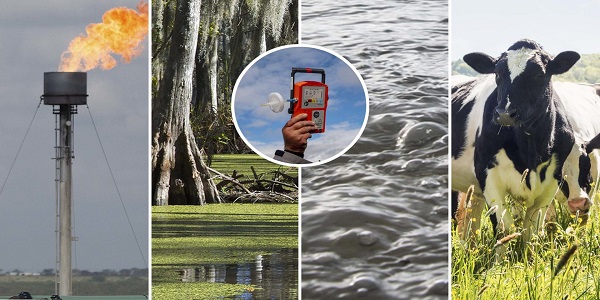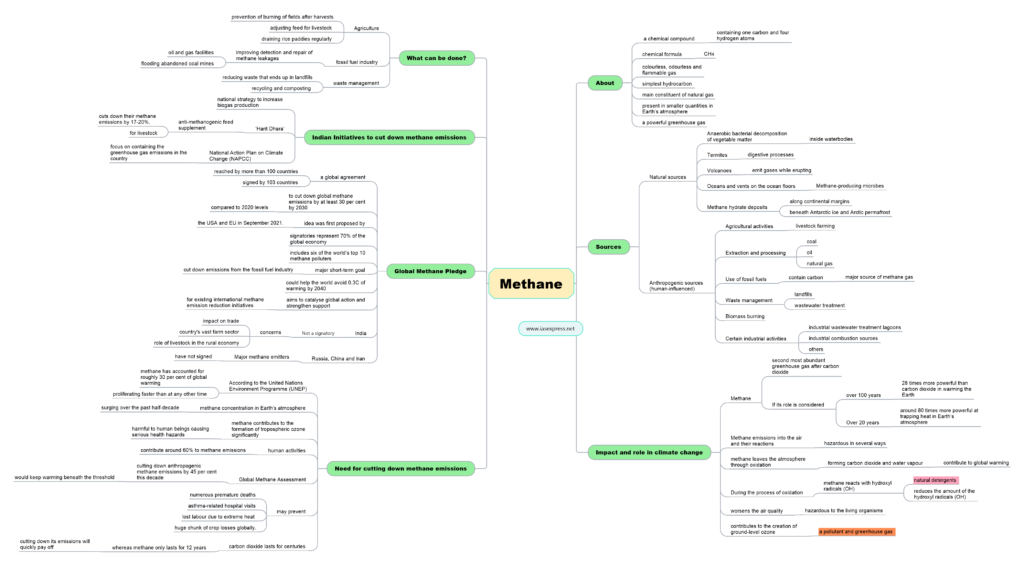Methane – Role in Climate Change and Global Methane Pledge

From Current Affairs Notes for UPSC » Editorials & In-depths » This topic
IAS EXPRESS Vs UPSC Prelims 2024: 85+ questions reflected
Recently, on the sidelines of the Glasgow summit, 2021, more than 100 countries have signed a pledge to cut down on methane emissions. The pledge is a first-of-its-kind global initiative to counter the effect of methane emissions and reduce its role in climate change. It not only sheds light on the role of methane in global warming but also how it has long been neglected by the global community. The pledge has also made methane a subject of immediate global scrutiny for reaching climate goals.

Methane – Introduction
- It is a chemical compound containing one carbon and four hydrogen atoms. Its chemical formula is CH4.
- It is a colourless, odourless and flammable gas.
- It is the simplest hydrocarbon and main constituent of natural gas.
- It is present in smaller quantities in Earth’s atmosphere but human activities have raised its concentration in the last few decades.
- It is a powerful greenhouse gas.
Sources of methane
- Natural sources
- Anaerobic bacterial decomposition of vegetable matter inside waterbodies where it is often known as marsh gas or swamp gas. Around 30% of methane is produced from this source and thus, wetlands are considered to be the major natural source of methane production
- Termites for their digestive processes. The total population of termites emit around 23 million tonnes of methane per year.
- Volcanoes as they emit gases while erupting.
- Oceans and vents on the ocean floors. Methane-producing microbes living in the ocean cause significant methane emissions. Globally, oceans create 19 million tonnes of methane per year.
- Methane hydrate deposits occurring along continental margins and beneath Antarctic ice and Arctic permafrost are also natural sources of methane.
- Anthropogenic sources (human-influenced)
- Agricultural activities especially livestock farming.
- Extraction and processing of coal, oil and natural gas.
- Use of fossil fuels since they are made up of organic matter and thus mainly contain carbon which is a major source of methane gas.
- Waste management that includes municipal solid waste landfills and wastewater treatment.
- Biomass burning. Estimates say that it produces 38 million tonnes of methane per year.
- Certain industrial activities such as industrial wastewater treatment lagoons, industrial combustion sources and others.
Impact of methane and its role in climate change
- Methane is the second most abundant greenhouse gas after carbon dioxide. However, it has a comparatively short life than carbon dioxide.
- If its role is considered over 100 years, methane is 28 times more powerful than carbon dioxide in warming the Earth. Over 20 years, it is around 80 times more powerful at trapping heat in Earth’s atmosphere.
- Methane emissions into the air and their reactions are hazardous in several ways.
- It mainly leaves the atmosphere through oxidation forming carbon dioxide and water vapour that in turn contribute to global warming.
- During the process of oxidation, methane reacts with hydroxyl radicals (OH) which are considered to be natural detergents as they clean methane and other pollutants from the environment.
- However, methane’s reaction with hydroxyl radicals reduces the amount of the latter’s molecules that might have been available to clean the presence of other air pollutants.
- It also worsens the air quality that might be hazardous to the living organisms causing various health issues in animals and premature human deaths.
- Methane also contributes to the creation of ground-level ozone in a major way. Ozone is a pollutant and greenhouse gas and thus causes 1 million premature deaths every year.
Need for cutting down methane emissions
- According to the United Nations Environment Programme (UNEP), methane has accounted for roughly 30 per cent of global warming since pre-industrial times and is proliferating faster than at any other time since record-keeping began in the 1980s.
- The methane concentration in Earth’s atmosphere has also been surging over the past half-decade.
- Additionally, methane contributes to the formation of tropospheric ozone (harmful to human beings causing serious health hazards) significantly.
- Although methane emissions are caused by both natural and anthropogenic sources, new studies suggest that human activities contribute around 60% to methane emissions which further aggravates global warming.
- The recent Global Methane Assessment launched by Climate and Clean Air Coalition (CCAC) and the United Nations Environment Programme (UNEP) found that cutting down anthropogenic methane emissions by 45 per cent this decade would keep warming beneath the threshold agreed by world leaders. Therefore, cutting down methane emissions is the need of the hour.
- Cutting down methane emissions may prevent numerous premature deaths, asthma-related hospital visits, lost labour due to extreme heat and a huge chunk of crop losses globally.
- Furthermore, carbon dioxide lasts for centuries in the atmosphere whereas methane only lasts for 12 years which means cutting down its emissions will quickly pay off and global temperatures can be easily lowered making it easier to reach Paris climate goals.
Global Methane Pledge
- It is a global agreement reached by more than 100 countries from all over the world to cut down global methane emissions by at least 30 per cent by 2030 compared to 2020 levels.
- It was signed by 103 countries on the sidelines of the COP26 summit held in Glasgow.
- The idea was first proposed by the USA and EU in September 2021.
- The signatories represent 70% of the global economy, including six of the world’s top 10 methane polluters.
- The major short-term goal of the pledge is to cut down emissions from the fossil fuel industry which can be achieved at little or no cost.
- Scientists believe that it could help the world avoid 0.3C of warming by 2040.
- The Pledge also aims to catalyse global action and strengthen support for existing international methane emission reduction initiatives to advance technical and policy work to help participant countries in their domestic actions.
- India has not signed the Global Methane Pledge despite being one of the top 10 emitters of methane since India is an agro-based economy and agriculture is one of the major anthropogenic sources of methane emission.
- India had concerns over the impact on trade, on the country’s vast farm sector, and the role of livestock in the rural economy.
- Major methane emitters like Russia, China and Iran have not signed the deal either.
- The Pledge is just a joint agreement made by countries voluntarily and it depends on the individual efforts of all the countries how successful it becomes in the long run.
Indian initiatives to counter methane emissions
- India’s anthropogenic methane emissions from agriculture (manure management), coal mines, municipal solid waste, and natural gas and oil systems account for approximately 20% of its methane emissions.
- To reduce methane emissions, the Ministry of New and Renewable Energy (MNRE), Government of India is investing heavily in the national strategy to increase biogas production. The focus areas of the strategy include:
- Numerous policy initiatives.
- Capacity building.
- Public-private partnerships.
- Another important initiative to cut down methane emissions is ‘Harit Dhara’.
- It is an anti-methanogenic feed supplement developed by the Indian Council of Agricultural Research (ICAR).
- When given to bovines and sheep, it cuts down their methane emissions by 17-20%.
- Since livestock is a major contributor to methane emissions, the ‘Harit Dhara’ initiative will play a greater role in cutting down emissions.
- The Government of India has been implementing the National Action Plan on Climate Change (NAPCC) to support domestic actions for adaptation and mitigation.
- NAPCC has eight National Missions. They include:
- The National Solar Mission
- National Mission for Enhanced Energy Efficiency
- National Mission on Sustainable Habitat and others.
- All of these focus on containing the greenhouse gas emissions in the country.
What can be done?
- Agriculture is a major contributor to methane emission thus it can adopt strategies such as prevention of burning of fields after harvests, adjusting feed for livestock and draining rice paddies regularly to cut down methane emissions.
- The fossil fuel industry may also help cut down emissions by improving detection and repair of methane leakages at oil and gas facilities and flooding abandoned coal mines that leak the gas.
- In the field of waste management, reducing waste that ends up in landfills, recycling and composting may help.
Way forward
Methane being a potent greenhouse gas has been a focus in peripheries for a long time. However, the recent global initiative has brought it into the central focus. Although several countries coming together to cut down methane emissions is a welcome initiative yet many high methane emitters still being out of the agreement is a matter of serious concern. Dedicated and coordinated fulfilment of goals set by the member countries may help reduce methane emissions globally in the long run.
Practise Question
Q. Will the Global Methane Pledge be able to fulfil its goals? Comment.
If you like this post, please share your feedback in the comments section below so that we will upload more posts like this.

